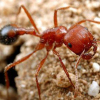
Location on map
 .
.Date of collection: Wednesday July 1st, 2020
Habitat of collection: very sandy and somewhat rocky.
Length: 8-9 mm
Color: some were light red, some were dark red, some were mixed, and some had a faint black stripe on abdomen.
Distinguishing characteristics: none
Distinguishing behavior: trying to dig in many places inches apart.
Nest description: the nest it was most likely raised in had 2 entrances and exits. 2 separate holes. Almost a perfect circle.
Nuptial flight time and date: exact time is unknown but the date was most likely the 30th or 29th of June.
Extra notes: I found 5 queens that I believe to be Pogonomyrmex Californicus. I was going fishing to have some easy fish for dinner. While entering the area I saw a large red ant that I believe to be a queen. I looked a little more for a while and ended up with 5 supposed queens. This was very unexpected because this place is covered in Argentine ants. The workers were kind of at war but also minding their own business. I killed as many argentines as I could and blocked off nest entrances.


I didn’t get photos of the nest or habitat but it was really just loose sand and small rocks.















